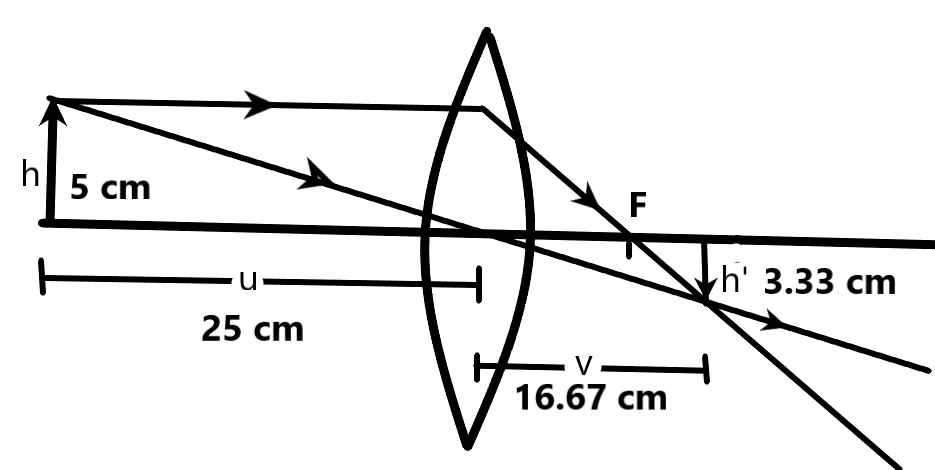
An object 5 cm in length is held 25 cm away from a converging lens of focal length 10 cm. Draw the ray diagram and find the position, size and the nature of the image formed.
Answer
558.3k+ views
Hint: We need to understand the image formation by the lenses when the object is placed at a point away from the lens. The position of the object determines the image position, the size of the image and the nature of the image formed due to the object.
Complete step-by-step answer:
We know that a converging lens forms the image of an object placed in front of it by converging the light rays falling on it. We can find the image distance very easily using the lens’ formula when the focal length and the object distance of the system is given.
According to the lens’ formula –
\[\dfrac{1}{f}=\dfrac{1}{v}-\dfrac{1}{u}\]
Where, f is the focal length of the lens,
v is the image distance,
u is the object distance.
It is given that the object is 25 cm away from the lens and the focal length of the lens is 10 cm. We can find the image distance by substituting the values as –
\[\begin{align}
& \dfrac{1}{f}=\dfrac{1}{v}-\dfrac{1}{u} \\
& \Rightarrow \dfrac{1}{v}=\dfrac{1}{f}+\dfrac{1}{u} \\
& \Rightarrow v=\dfrac{uf}{u+f} \\
& \Rightarrow v=\dfrac{(-25cm)(+10cm)}{-25+10} \\
& \therefore v=+\dfrac{50}{3}cm=+16.67cm \\
\end{align}\]
We can find the magnification of the image formed by finding the ratio between the image distance to the object distance. This is given by –
\[\begin{align}
& m=\dfrac{v}{u} \\
& \Rightarrow m=\dfrac{\dfrac{50}{3}}{-25} \\
& \therefore m=-\dfrac{2}{3} \\
\end{align}\]
From this we can conclude that the image is two-third of the object size. The image size can be given as –
\[\begin{align}
& h'=mh \\
& \Rightarrow h'=-\dfrac{2}{3}(5) \\
& \therefore h'=-\dfrac{10}{3}cm=3.33cm \\
\end{align}\]
The image size has a negative sign, this implies that the image formed is real and inverted.

The image is formed 16.67 cm away from the lens. The image size is 3.33 cm. The image is real and inverted.
This is the required solution.
Note: The converging lenses need not to convex lenses. A concave lens when submerged in a medium with greater refractive index means that the material of the lens can also act as a converging lens. We should not be confused by this while solving problems.
Complete step-by-step answer:
We know that a converging lens forms the image of an object placed in front of it by converging the light rays falling on it. We can find the image distance very easily using the lens’ formula when the focal length and the object distance of the system is given.
According to the lens’ formula –
\[\dfrac{1}{f}=\dfrac{1}{v}-\dfrac{1}{u}\]
Where, f is the focal length of the lens,
v is the image distance,
u is the object distance.
It is given that the object is 25 cm away from the lens and the focal length of the lens is 10 cm. We can find the image distance by substituting the values as –
\[\begin{align}
& \dfrac{1}{f}=\dfrac{1}{v}-\dfrac{1}{u} \\
& \Rightarrow \dfrac{1}{v}=\dfrac{1}{f}+\dfrac{1}{u} \\
& \Rightarrow v=\dfrac{uf}{u+f} \\
& \Rightarrow v=\dfrac{(-25cm)(+10cm)}{-25+10} \\
& \therefore v=+\dfrac{50}{3}cm=+16.67cm \\
\end{align}\]
We can find the magnification of the image formed by finding the ratio between the image distance to the object distance. This is given by –
\[\begin{align}
& m=\dfrac{v}{u} \\
& \Rightarrow m=\dfrac{\dfrac{50}{3}}{-25} \\
& \therefore m=-\dfrac{2}{3} \\
\end{align}\]
From this we can conclude that the image is two-third of the object size. The image size can be given as –
\[\begin{align}
& h'=mh \\
& \Rightarrow h'=-\dfrac{2}{3}(5) \\
& \therefore h'=-\dfrac{10}{3}cm=3.33cm \\
\end{align}\]
The image size has a negative sign, this implies that the image formed is real and inverted.

The image is formed 16.67 cm away from the lens. The image size is 3.33 cm. The image is real and inverted.
This is the required solution.
Note: The converging lenses need not to convex lenses. A concave lens when submerged in a medium with greater refractive index means that the material of the lens can also act as a converging lens. We should not be confused by this while solving problems.
Recently Updated Pages
Master Class 12 English: Engaging Questions & Answers for Success

Master Class 12 Business Studies: Engaging Questions & Answers for Success

Master Class 12 Economics: Engaging Questions & Answers for Success

Master Class 12 Social Science: Engaging Questions & Answers for Success

Master Class 12 Maths: Engaging Questions & Answers for Success

Master Class 12 Chemistry: Engaging Questions & Answers for Success

Trending doubts
What are the major means of transport Explain each class 12 social science CBSE

Which are the Top 10 Largest Countries of the World?

Draw a labelled sketch of the human eye class 12 physics CBSE

Explain sex determination in humans with line diag class 12 biology CBSE

The pH of the pancreatic juice is A 64 B 86 C 120 D class 12 biology CBSE

Explain sex determination in humans with the help of class 12 biology CBSE




